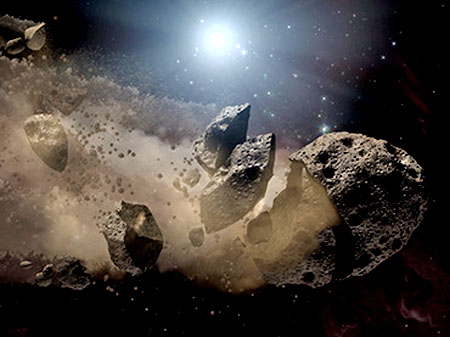|

19 February, 2013
from
RT
Website

Image credit:
NASA/JPL-Caltech
Moscow believes an operable national defense against threats from
outer space can be built within 10 years’ time. The
500-kiloton explosion of a space bolide above
the Urals region has sped-up allocation of some $2
billion to prevent future threats.
Russian scientists have presented a federal program designed to
counteract space threats.
Elaborated by the Institute of Astronomy
at Russia’s Academy of Sciences and the Central Engineering
Research Institute (RAS),
Russia’s leading space industry enterprise, the program has already
been approved by Roskosmos, the national space agency.
The program has nothing to do with Hollywood sci-fi movie scenarios;
no lasers, annihilators or Bruce Willis drilling a huge peace of
rock rushing towards Earth.
The system will consist of a network of robotic telescopes
monitoring space around our planet, some of them delivered to orbit,
others operating from the surface.
Destruction of an asteroid in emergency cases may be performed by a
rocket with a powerful megaton-class thermonuclear warhead. If the
threat is detected early, more advanced means of changing an
asteroid’s orbit may be considered.
The program costing 58 billion rubles (over $1.9 billion) has
already been handed over to the head of Russia’s defense industry,
Deputy PM Dmitry Rogozin who is expected to present it to
Prime Minister Dmitry Medvedev.
Lidia Rykhlova from the Institute of Astronomy of RAS, who
presented the project, reported that Russia will need to modernize
and fully computerize the 60 cm lens telescopes it already has.
Several larger telescopes with 2 meter lens will have to be
additionally installed.
Rykhlova announced that an analytical center will be created to
collect the data from various sources and analyze it in real time
mode.
Professor of the Moscow State University, head of the laboratory for
space monitoring Vladimir Lipunov told Interfax news agency
that it will take about two years to modernize all Russia’s existing
nine telescopes with the diameter of the lens of 40 centimeters and
unite them into one network.
A network of larger telescopes across
the globe could be ready in five years.
“It will cost a mere trifle. What
[Russian billionaire] Roman Abramovich paid for Chelsea
[football club] would cover all the costs of the project,”
Lipunov said.
According to Forbes during the eight
years of owning Chelsea, Abramovich spent $1.3 billion on the
football club.
Lipunov stressed that tracking and forecasting space threats is more
real and efficient than engaging air defense systems to deal with
meteorites in the atmosphere, as people could be evacuated from an
impact zone in advance.
Asteroid
threat is growing by the year
“There are a lot of asteroids
orbiting close to Earth and every year up to 1,000 more are
being discovered,” Lidia Rykhlova said, specifying that three
years ago the number of known asteroids passing close to our
planet was about 7,000 and now their number has grown up to
around 9,400.
Most of the relatively large asteroids,
with a diameter of one kilometer and larger are already known.
“We know about 90 per cent of
kilometer-class asteroids, their orbits are well known and
predictable. As for the smaller 40-50 meter ones - we still have
insufficient observation apparatus. The more we observe - the
more of them we find,” Rykhlova acknowledged.
If the space object is discovered
beforehand, at least a month prior to possible collision with Earth,
there is time to find out its size and consider various measures of
its elimination.
The execution of a really complicated operation will require at
least a year, Rykhlova pointed out.
“Therefore our emergency aid is a
rocket with a nuclear warhead,” she concluded.
|

